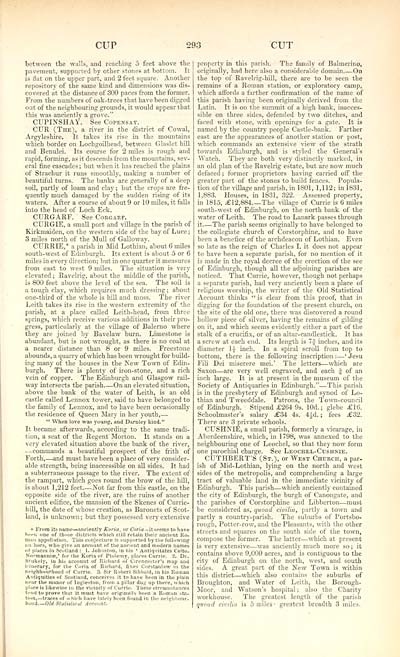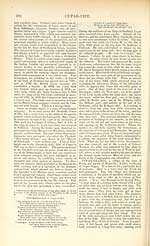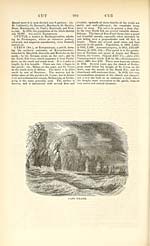Topographical, statistical, and historical gazetteer of Scotland > Volume 1
(375) Page 293
Download files
Complete book:
Individual page:
Thumbnail gallery: Grid view | List view

CUP
293
CUT
between the walls, and reaching 5 feet above the
pavement, supported by other stones at bottom. It
is flat on the upper part, and 2 feet square. Another
repository of the same kind and dimensions was dis-
covered at the distance of 300 paces from the former.
From the numbers of oak-trees that have been digged
out of the neighbouring grounds, it would appear that
this was anciently a grove."
CUPINSHAY. See Copensay.
CUR (The), a river in the district of Cowal,
Argyleshire. It takes its rise in the mountains
which border on Lochgoilhead, between Glaslet hill
and Benulei. Its course for 2 miles is rough and
rapid, forming, as it descends from the mountains, sev-
eral fine cascades; but when it has reached the plains
of Strachur it runs smoothly, making a number of
beautiful turns. The banks are generally of a deep
soil, partly of loam and clay ; but the crops are fre-
quently much damaged by the sudden rising of its
waters. After a course of about 9 or 10 miles, it falls
into the head of Loch Eck.
CURGARF. See Corgakf.
CURGIE, a small port and village in the parish of
Kirkmaiden, on the western side of the bay of Luce;
3 miles north of the Mull of Galloway.
CURRIE,* a parish in Slid Lothian, about 6 miles
south-west of Edinburgh. Its extent is about 5 or 6
miles in every direction; but in one quarter it measures
from east to west 9 miles. The situation is very-
elevated ; Ravelrig, about the middle of the parish,
is 800 feet above the level of the sea. The soil is
a tough clay, which requires much dressing ; about
one-third of the whole is hill and moss. The river
Leith takes its rise in the western extremity of the
parish, at a place called Leith-head, from three
springs, which receive various additions in their pro-
gress, particularly at the village of Balerno where
they are joined by Bavelaw burn. Limestone is
abundant, but is not wrought, as there is no coal at
a nearer distance than 8 or 9 miles. Freestone
abounds, a quarry of which has been wrought for build-
ing many of the houses in the New Town of Edin-
burgh. There is plenty of iron-stone, and a rich
vein of copper. The Edinburgh and Glasgow rail-
way intersects the parish On an elevated situation,
above the bank of the water of Leith, is an old
castle called Lennox tower, said to have belonged to
the family of Lennox, and to have been occasionally
the residence of Queen Mary in her youth, —
" When love was youn-g, and Darnley kind."
It became afterwards, according to the same tradi-
tion, a seat of the Regent Morton. It stands on a
very elevated situation above the bank of the river,
— commands a beautiful prospect of the frith of
Forth, — and must have been a place of very consider-
able strength, bemg inaccessible on all sides. It had
a subterraneous passage to the river. The extent of
the rampart, which goes round the brow of the hill,
is about 1,212 feet. — Not far from this castle, on the
opposite side of the river, are the ruins of another
ancient edifice, the mansion of the Skenes of Currie-
hill, the date of whose creation, as Baronets of Scot-
land, is unknown; but they possessed very extensive
* From its name— anciently Koria, or Coria— itseems to have
h~e r. one of th'ise districts which still retain their ancient Ro-
man appellation. This conjecture is supported by the following
ait hors, who give an account of the ancient and modera names
of places in Scotland : I. Johnston, in his ' Antiquitates Celto-
NnrmanniaV for the Koria of Ptolemy, places Currie. 2. Dr.
Srnkely, in he= account of Richard of Cirencester's map and
itinerary, for the Curia of Richard, fixes Corstanlaw in the
neighbourhood of Currie. 3. Sir Robert Sibbald, in his Roman
Antiquities of Scotland, conceives it to have been in the plain
near the manor of Ingleston, from a pillar du^' up there, which
place is likewise in the vicinity of Currie. These circumstances
tend to prove that it must have originally been a Roman sta-
tion, — traces of ivhi.-h have lately been found in the neighbour-
hood — Old Statistical Account.
property in this parish. The family of Balmerino,
originally, had here also a considerable domain On
the top of Ravelrig-hill, there are to be seen the
remains of a Roman station, or exploratory camp,
which affords a farther confirmation of the name of
this parish having been originally derived from the
Latin. It is on the summit of a high bank, inacces-
sible on three sides, defended by two ditches, and
faced with stone, with openings for a gate. It is
named by the country people Castle-bank. Farther
east are the appearances of another station or post,
which commands an extensive view of the strath
towards Edinburgh, and is styled the General's
Watch. They are both very distinctly marked, in
an old plan of the Ravelrig estate, but are now much
defaced ; former proprietors having carried off the
greater part of the stones to build fences. Popula-
tion of the village and parish, in 1801, 1,112; in 1831,
1,883. Houses, in 1831, 322. Assessed property,
in 1815, £12,884 The village of Currie is 6 miles
south-west of Edinburgh, on the north bank of the
water of Leith. The road to Lanark passes through
it The parish seems originally to have belonged to
the collegiate church of Corstorphine, and to have
been a benefice of the archdeacon of Lothian. Even
so late as the reign of Charles I. it does not appear
to have been a separate parish, for no mention of it
is made in the royal decree of the erection of the see
of Edinburgh, though all the adjoining parishes are
noticed. That Currie, however, though not perhaps
a separate parish, had very anciently been a place of
religious worship, the writer of the Old Statistical
Account thinks " is clear from this proof, that in
digging for the foundation of the present church, on
the site of the old one, there was discovered a round
hollow piece of silver, having the remains of gilding
on it, and which seems evidently either a part of the
stalk of a crucifix, or of an altar-candlestick. It has
a screw at each end. Its length is 7f inches, and its
diameter 1-^ inch. In a spiral scroll from top to
bottom, there is the following inscription : — ' Jesu
Fili Dei miserere mei.' The letters — which are
Saxon — are very well engraved, and each |- of an
inch large. It is at present in the museum of the
Society of Antiquaries in Edinburgh." — This parish
is in the presbytery of Edinburgh and synod of Lo-
thian and Tweeddale. Patrons, the Town-council
of Edinburgh. Stipend £264 9s. lOd. ; glebe ±"16.
Schoolmaster's salary .£34 4s. 4gd. ; fees £32.
There are 3 private schools.
CUSHNlfi, a small parish, formerly a vicarage, in
Aberdeenshire, which, in 1798, was annexed to the
neighbouring one of Leochel, so that they now form
one parochial charge. See Leochel-Cushnie.
CUTHBERT'S (St.), or West Church, a par-
ish of Mid-Lothian, lying on the north and west
sides of the metropolis, and comprehending a large
tract of valuable land in the immediate vicinity of
Edinburgh. This parish — which anciently contained
the city of Edinburgh, the burgh of Canongate, and
the parishes of Corstorphine and Libberton — must
be considered as, quoad civilia, partly a town and
partly a country-parish. The suburbs of Portsbo-
rough, Potter-row, and the Pleasants, with the other
streets and squares on the south side of the town,
compose the former. The latter — which at present
is very extensive — was anciently much more so ; it
contains above 9,000 acres, and is contiguous to the
city of Edinburgh on the north, west, and south
sides. A great part of the New Town is within
this district — which also contains the suburbs of
Broughton, and Water of Leith, the Borough-
Moor, and Watson's hospital ; also the Charity
workhouse. The greatest length of the parish
quoad civilia is 5 miles • greatest breadth 3 miles.
293
CUT
between the walls, and reaching 5 feet above the
pavement, supported by other stones at bottom. It
is flat on the upper part, and 2 feet square. Another
repository of the same kind and dimensions was dis-
covered at the distance of 300 paces from the former.
From the numbers of oak-trees that have been digged
out of the neighbouring grounds, it would appear that
this was anciently a grove."
CUPINSHAY. See Copensay.
CUR (The), a river in the district of Cowal,
Argyleshire. It takes its rise in the mountains
which border on Lochgoilhead, between Glaslet hill
and Benulei. Its course for 2 miles is rough and
rapid, forming, as it descends from the mountains, sev-
eral fine cascades; but when it has reached the plains
of Strachur it runs smoothly, making a number of
beautiful turns. The banks are generally of a deep
soil, partly of loam and clay ; but the crops are fre-
quently much damaged by the sudden rising of its
waters. After a course of about 9 or 10 miles, it falls
into the head of Loch Eck.
CURGARF. See Corgakf.
CURGIE, a small port and village in the parish of
Kirkmaiden, on the western side of the bay of Luce;
3 miles north of the Mull of Galloway.
CURRIE,* a parish in Slid Lothian, about 6 miles
south-west of Edinburgh. Its extent is about 5 or 6
miles in every direction; but in one quarter it measures
from east to west 9 miles. The situation is very-
elevated ; Ravelrig, about the middle of the parish,
is 800 feet above the level of the sea. The soil is
a tough clay, which requires much dressing ; about
one-third of the whole is hill and moss. The river
Leith takes its rise in the western extremity of the
parish, at a place called Leith-head, from three
springs, which receive various additions in their pro-
gress, particularly at the village of Balerno where
they are joined by Bavelaw burn. Limestone is
abundant, but is not wrought, as there is no coal at
a nearer distance than 8 or 9 miles. Freestone
abounds, a quarry of which has been wrought for build-
ing many of the houses in the New Town of Edin-
burgh. There is plenty of iron-stone, and a rich
vein of copper. The Edinburgh and Glasgow rail-
way intersects the parish On an elevated situation,
above the bank of the water of Leith, is an old
castle called Lennox tower, said to have belonged to
the family of Lennox, and to have been occasionally
the residence of Queen Mary in her youth, —
" When love was youn-g, and Darnley kind."
It became afterwards, according to the same tradi-
tion, a seat of the Regent Morton. It stands on a
very elevated situation above the bank of the river,
— commands a beautiful prospect of the frith of
Forth, — and must have been a place of very consider-
able strength, bemg inaccessible on all sides. It had
a subterraneous passage to the river. The extent of
the rampart, which goes round the brow of the hill,
is about 1,212 feet. — Not far from this castle, on the
opposite side of the river, are the ruins of another
ancient edifice, the mansion of the Skenes of Currie-
hill, the date of whose creation, as Baronets of Scot-
land, is unknown; but they possessed very extensive
* From its name— anciently Koria, or Coria— itseems to have
h~e r. one of th'ise districts which still retain their ancient Ro-
man appellation. This conjecture is supported by the following
ait hors, who give an account of the ancient and modera names
of places in Scotland : I. Johnston, in his ' Antiquitates Celto-
NnrmanniaV for the Koria of Ptolemy, places Currie. 2. Dr.
Srnkely, in he= account of Richard of Cirencester's map and
itinerary, for the Curia of Richard, fixes Corstanlaw in the
neighbourhood of Currie. 3. Sir Robert Sibbald, in his Roman
Antiquities of Scotland, conceives it to have been in the plain
near the manor of Ingleston, from a pillar du^' up there, which
place is likewise in the vicinity of Currie. These circumstances
tend to prove that it must have originally been a Roman sta-
tion, — traces of ivhi.-h have lately been found in the neighbour-
hood — Old Statistical Account.
property in this parish. The family of Balmerino,
originally, had here also a considerable domain On
the top of Ravelrig-hill, there are to be seen the
remains of a Roman station, or exploratory camp,
which affords a farther confirmation of the name of
this parish having been originally derived from the
Latin. It is on the summit of a high bank, inacces-
sible on three sides, defended by two ditches, and
faced with stone, with openings for a gate. It is
named by the country people Castle-bank. Farther
east are the appearances of another station or post,
which commands an extensive view of the strath
towards Edinburgh, and is styled the General's
Watch. They are both very distinctly marked, in
an old plan of the Ravelrig estate, but are now much
defaced ; former proprietors having carried off the
greater part of the stones to build fences. Popula-
tion of the village and parish, in 1801, 1,112; in 1831,
1,883. Houses, in 1831, 322. Assessed property,
in 1815, £12,884 The village of Currie is 6 miles
south-west of Edinburgh, on the north bank of the
water of Leith. The road to Lanark passes through
it The parish seems originally to have belonged to
the collegiate church of Corstorphine, and to have
been a benefice of the archdeacon of Lothian. Even
so late as the reign of Charles I. it does not appear
to have been a separate parish, for no mention of it
is made in the royal decree of the erection of the see
of Edinburgh, though all the adjoining parishes are
noticed. That Currie, however, though not perhaps
a separate parish, had very anciently been a place of
religious worship, the writer of the Old Statistical
Account thinks " is clear from this proof, that in
digging for the foundation of the present church, on
the site of the old one, there was discovered a round
hollow piece of silver, having the remains of gilding
on it, and which seems evidently either a part of the
stalk of a crucifix, or of an altar-candlestick. It has
a screw at each end. Its length is 7f inches, and its
diameter 1-^ inch. In a spiral scroll from top to
bottom, there is the following inscription : — ' Jesu
Fili Dei miserere mei.' The letters — which are
Saxon — are very well engraved, and each |- of an
inch large. It is at present in the museum of the
Society of Antiquaries in Edinburgh." — This parish
is in the presbytery of Edinburgh and synod of Lo-
thian and Tweeddale. Patrons, the Town-council
of Edinburgh. Stipend £264 9s. lOd. ; glebe ±"16.
Schoolmaster's salary .£34 4s. 4gd. ; fees £32.
There are 3 private schools.
CUSHNlfi, a small parish, formerly a vicarage, in
Aberdeenshire, which, in 1798, was annexed to the
neighbouring one of Leochel, so that they now form
one parochial charge. See Leochel-Cushnie.
CUTHBERT'S (St.), or West Church, a par-
ish of Mid-Lothian, lying on the north and west
sides of the metropolis, and comprehending a large
tract of valuable land in the immediate vicinity of
Edinburgh. This parish — which anciently contained
the city of Edinburgh, the burgh of Canongate, and
the parishes of Corstorphine and Libberton — must
be considered as, quoad civilia, partly a town and
partly a country-parish. The suburbs of Portsbo-
rough, Potter-row, and the Pleasants, with the other
streets and squares on the south side of the town,
compose the former. The latter — which at present
is very extensive — was anciently much more so ; it
contains above 9,000 acres, and is contiguous to the
city of Edinburgh on the north, west, and south
sides. A great part of the New Town is within
this district — which also contains the suburbs of
Broughton, and Water of Leith, the Borough-
Moor, and Watson's hospital ; also the Charity
workhouse. The greatest length of the parish
quoad civilia is 5 miles • greatest breadth 3 miles.
Set display mode to: Large image | Transcription
Images and transcriptions on this page, including medium image downloads, may be used under the Creative Commons Attribution 4.0 International Licence unless otherwise stated. ![]()
| Gazetteers of Scotland, 1803-1901 > Topographical, statistical, and historical gazetteer of Scotland > Volume 1 > (375) Page 293 |
|---|
| Permanent URL | https://digital.nls.uk/97442046 |
|---|
| Description | Volume first. A-H. |
|---|---|
| Attribution and copyright: |
|

